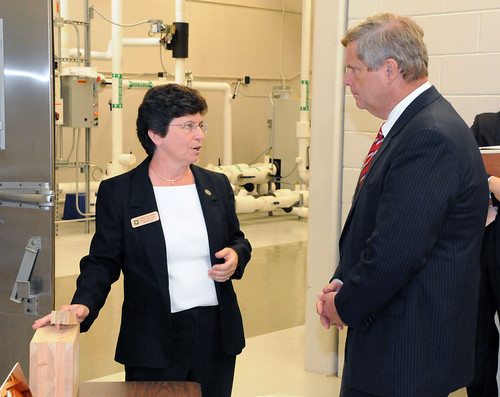
The Forest Products Laboratory (FPL) recently guided USDA Secretary Tom Vilsack through its unique set of research facilities. Basic and applied research at FPL supports a number of objectives, including forest management and restoration, the wise use of forest resources, job creation, and expanding economic opportunities through public-private partnerships on a national scale.
Throughout his tour, Secretary Vilsack talked with lab leadership about FPL’s diverse and innovative research efforts. Project leaders used the opportunity to field questions from the Secretary and explain work ranging from wood preservation and durability to advances in “green” building strategies and technology, use of beetle-killed trees, work on historic timber bridges, and advances in nanocellulose-related materials and applications.
In FPL’s unique weather testing facility, project leader Carol Clausen described how wall assemblies can be tested for a range of harsh conditions, from heavy rain and extreme heat to high humidity and strong winds.
“Developing durable building materials for green construction is a win-win situation for the Nation’s forests and the American people,” Clausen told Vilsack. “Utilizing beetle-killed trees to create value-added products, improves forest health, reduces the wildfire threat and creates jobs.”
In the Engineering Mechanics and Remote Sensing Laboratory, project leader Bob Ross brought out the big gun—an air-powered debris launcher used to develop protective safe-rooms in hurricane and tornado-prone areas. The Secretary watched as the unique air-cannon blasted an eight-foot, 2x4 board into a test wall of cross-laminated material at over 100 miles per hour. The board didn’t shatter but the test-wall took quite a dent.
In the world renowned Nanocellulose Pilot Plant, project leader Alan Rudie walked the Secretary through some of FPL’s most advanced equipment. High-strength and extremely versatile, nanocellulose materials can be used for a variety of applications including ballistic glass; small, powerful transistors; and heat-resistant additives for concrete, among many other uses.
Zhiyong Cai, project leader for FPL’s engineered composite science unit, demonstrated uses for cellulose nanofibrils material in bio-degradable electronic parts, high performance insolation aerogel material, and regenerated cellulose braided reinforced fabric.
“The Secretary was very interested in nanotechnology applications in forest products research,” said Cai. “He was impressed with the impact that cellulose nanomaterial could bring to not only the forest products industry, but also electronics and other industries.”

